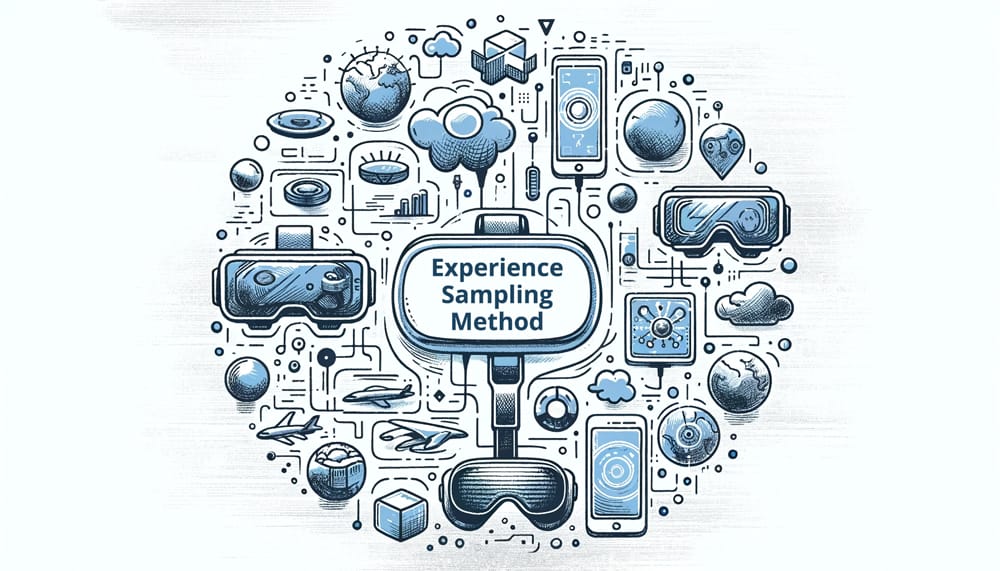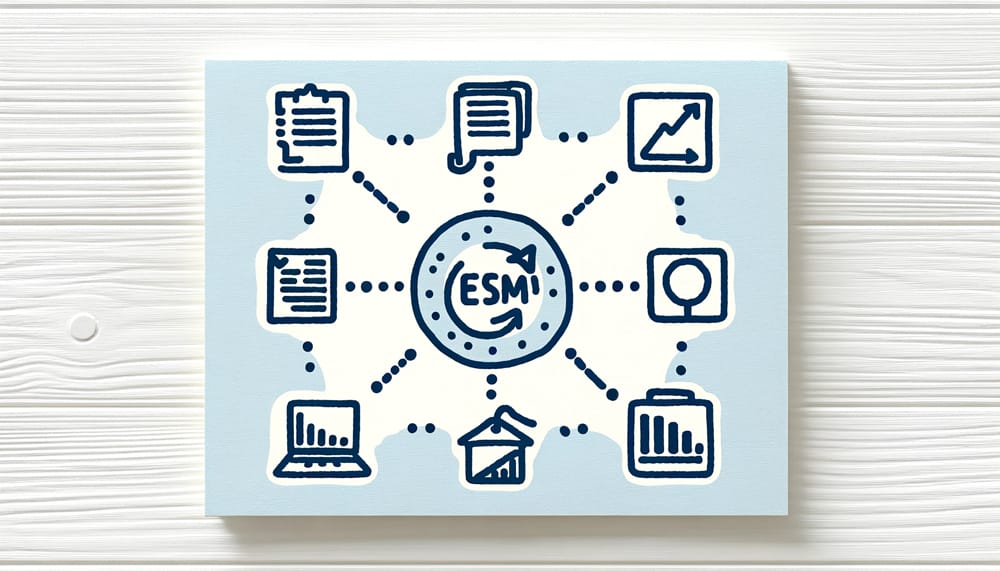Introduction to ESM Study Design
Exploring the Experience Sampling Method
The Experience Sampling Method (ESM) stands as a dynamic research tool, widely recognized for its ability to capture real-time data and insights into individuals’ daily lives and experiences. At its core, ESM involves prompting participants to report on their thoughts, feelings, behaviors, and environments at multiple times over a period. This method’s strength lies in its immediacy and contextual relevance, offering a window into the nuanced tapestry of human experiences as they unfold naturally.
“ESM: A lens focusing on the intricate details of daily life, capturing moments as they occur in their natural environment.”
For a comprehensive understanding of ESM, consider exploring “Introduction to Experience Sampling Method (ESM)”, which provides a foundational overview of this innovative research methodology.
The Importance of Thoughtful Study Design
In ESM research, thoughtful study design is not just a best practice; it’s a necessity. The effectiveness of an ESM study hinges on how well the study is designed to meet its objectives. A well-structured ESM study design ensures:
-
- Accuracy and Relevance: The data collected is directly related to the research questions and objectives.
-
- Participant Engagement: A design that considers the participant’s experience increases compliance and the quality of data.
-
- Feasibility and Efficiency: Efficient design maximizes resources and time, both for researchers and participants.
“In the realm of ESM, the elegance of the study design is as crucial as the richness of the data collected.”
To delve deeper into the nuances of ESM study design, resources like Designing an ESM Study: Key Considerations and Steps offer valuable insights and guidelines, aiding researchers in crafting studies that are both robust and insightful.
In summary, the introduction to ESM study design underscores the method’s potential in capturing rich, contextual data and emphasizes the critical role of meticulous planning and structuring of the study to harness this potential fully. The journey of an ESM study begins with a design that is thoughtfully aligned with its aims, ensuring that every step taken is a stride towards deeper understanding and discovery.
Defining the Research Question

Crafting Clear and Focused Research Questions
The cornerstone of any successful Experience Sampling Method (ESM) study is a well-defined research question. A clear and focused research question not only guides the overall direction of the study but also ensures that the data collected is relevant and meaningful. Here are key steps to articulate effective research questions in ESM studies:
- Identify the Core Objective: Begin by pinpointing what you aim to discover or understand through your study. This central objective will serve as the foundation for your research question.
- Explore the Specifics: Delve into specifics by considering the aspects of daily experience or behavior that you wish to explore. The more specific your question, the more targeted your data collection will be.
- Ensure Feasibility: Assess the feasibility of your question. Can it realistically be answered through ESM? Ensure that the question aligns with the method’s strengths and limitations.
- Refine for Clarity: A good research question is both clear and concise. It should be easily understandable and focused enough to guide your study without ambiguity.
“A well-crafted research question in ESM is like a compass, guiding every step of the study towards meaningful insights.”
Aligning ESM Methodology with Research Objectives
Once you have a clear research question, the next step is to align the ESM methodology with your research objectives:
- Match Methods to Objectives: Ensure that the ESM approach you choose effectively addresses your research question. Different ESM techniques might be better suited for different types of questions.
- Consider the Participant Experience: Align your methodology with what is reasonable to expect from participants. The frequency and type of prompts should yield the required data without overburdening them.
- Plan for Data Analysis: Consider how you will analyze the data in line with your research question. This foresight ensures that you collect data in a format that can be effectively analyzed to answer your question.
To gain a deeper understanding of aligning your research question with ESM methodology, exploring resources like Setting Up ESM Data Collection: Tools and Best Practices can be immensely beneficial.
In summary, defining a clear and focused research question is a critical step in designing an ESM study. It not only shapes the structure of your study but also ensures that your methodology is precisely tuned to capture the data needed to answer your research question effectively and efficiently.
Selecting Variables and Measures

Criteria for Choosing Appropriate Variables and Measures
In Experience Sampling Method (ESM) studies, selecting the right variables and measures is crucial for gathering meaningful data that accurately addresses the research question. Here are key criteria to consider when choosing variables and measures:
- Relevance to Research Question: Ensure that each variable and measure directly relates to your research question. They should provide insight into the aspects of experience or behavior you are investigating.
- Measurability in Real-Time: Given ESM’s focus on immediate experiences, choose variables and measures that participants can easily report in real-time. They should be clear, understandable, and easily observable or felt by participants.
- Validity and Reliability: Opt for measures that are both valid (accurately capturing what they are supposed to measure) and reliable (providing consistent results over time).
- Sensitivity to Change: Select variables that are sensitive enough to capture changes over the course of the study. This is especially important in ESM, where tracking fluctuations over time is often key.
“Choosing the right variables in ESM is like selecting the right ingredients for a recipe – each one should contribute to the overall flavor of the study.”
Ensuring the privacy and confidentiality of participant data, as highlighted in Ethical Considerations in ESM Research.
Balancing Breadth and Depth in Variable Selection
Achieving a balance between breadth and depth in variable selection is critical:
-
- Breadth: Including a wide range of variables can provide a comprehensive overview of the experiences or behaviors being studied. However, too many variables can overwhelm participants and dilute the focus of the study.
-
- Depth: Focusing deeply on a few key variables allows for a more detailed exploration of specific aspects of the participant’s experience. However, too narrow a focus may miss important contextual factors.
Balancing these two aspects involves careful consideration of the study’s goals and the capacity of participants to provide detailed and accurate responses. It’s important to strike a balance that provides rich, insightful data without overburdening participants.
For guidance on selecting the most appropriate variables and measures for your ESM study, resources like Analyzing ESM Data: A Step-by-Step Guide can be extremely helpful.
In conclusion, the selection of variables and measures in an ESM study is a delicate balancing act. It requires aligning the variables with the research question, ensuring they are measurable and sensitive to change, and finding the right mix of breadth and depth to fully explore the topic at hand without overwhelming the participants or the study design.
Determining Sampling Methods

Overview of Different Sampling Techniques in ESM
In the context of Experience Sampling Method (ESM) studies, the choice of sampling technique is a pivotal decision that can significantly influence the study’s outcomes. Various sampling methods cater to different research needs and constraints. Here are some common techniques used in ESM:
- Random Sampling: Participants are selected randomly from the target population. This method is ideal for studies aiming for generalizability across a broader population.
- Stratified Sampling: The population is divided into subgroups (strata), and participants are randomly selected from each subgroup. This method ensures representation from all key segments of the population.
- Convenience Sampling: Participants are chosen based on their availability and willingness. While less rigorous, it’s useful for exploratory studies or when resources are limited.
- Quota Sampling: Similar to stratified sampling, but selection within each subgroup is non-random, based on certain predefined quotas.
- Snowball Sampling: Used particularly for hard-to-reach populations, where existing study participants recruit future participants from their acquaintances.
Each of these methods has its strengths and limitations, and the choice largely depends on the study’s objectives, the nature of the research question, and the characteristics of the target population.
For more insights on creating participant-friendly prompt schedules, Participant Engagement in ESM Studies offers valuable strategies and tips.
How to Choose the Right Sampling Strategy for Your Study
Selecting the appropriate sampling strategy involves several considerations:
- Align with Research Objectives: The sampling method should directly support the research question and objectives. For instance, if the goal is to generalize findings, a random sampling method might be preferred.
- Consider the Target Population: The nature of the target population can influence the choice of sampling. For example, snowball sampling could be effective for studying niche or hard-to-reach groups.
- Resource Constraints: Factor in the available resources, including time, budget, and personnel. Methods like convenience sampling can be more feasible under tight resource constraints.
- Evaluate Potential Biases: Consider how different sampling methods might introduce biases into your study and how these can be mitigated.
For an in-depth exploration of sampling methods in ESM and how to apply them effectively, resources like Technological Innovations in ESM Data Collection offer valuable insights and examples.
In conclusion, determining the right sampling method in ESM is a critical step that requires careful consideration of the study’s goals, the nature of the population, and practical limitations. A well-chosen sampling strategy not only enhances the quality of the data collected but also ensures the relevance and applicability of the study’s findings.
Developing ESM Prompts

Crafting Effective and Engaging ESM Prompts
In Experience Sampling Method (ESM) studies, the prompts used to elicit responses from participants are pivotal in gathering high-quality data. Effective and engaging prompts can significantly enhance participant engagement and the accuracy of the data collected. Here’s how to craft compelling ESM prompts:
- Be Clear and Concise: Prompts should be straightforward and easy to understand. Avoid complex language or jargon that might confuse participants.
- Context-Specific: Tailor your prompts to the context of your study. Ensure they are relevant to the experiences or behaviors you are investigating.
- Engaging and Thought-Provoking: Design prompts that are engaging and encourage participants to reflect on their experiences. Thought-provoking questions can yield richer and more detailed responses.
- Balance Openness and Specificity: While open-ended prompts can provide depth, too much openness can lead to vague responses. Balance this with specific prompts that guide participants to provide the information you’re seeking.
“Effective ESM prompts are like keys unlocking the rich, nuanced narratives of participants’ experiences.”
For a deeper understanding of prompt timing strategies and technology applications in ESM, Technological Innovations in ESM Data Collection provides comprehensive insights.
Ensuring Clarity and Relevance in Prompt Design
Clarity and relevance in ESM prompt design are essential for obtaining useful and accurate data:
- Relevance to Research Question: Each prompt should tie back directly to your research question. Irrelevant prompts can detract from the focus of your study and burden participants.
- Consider Timing and Frequency: The timing and frequency of prompts should be planned to capture relevant data without causing fatigue or annoyance to participants. This is crucial for maintaining engagement throughout the study.
- Test for Clarity: Pilot test your prompts with a small group to ensure they are understood as intended. Feedback can help refine prompts for clarity and effectiveness.
For additional insights into designing effective ESM prompts, exploring resources like Crafting Effective ESM Prompts: Tips and Examples can be highly beneficial.
In conclusion, the development of ESM prompts is an art that requires careful consideration of clarity, relevance, engagement, and the balance between openness and specificity. Well-crafted prompts are instrumental in eliciting rich, meaningful responses, thereby enhancing the overall quality and depth of data collected in ESM studies.
For more insights into the impact of prompt frequency in ESM and strategies to optimize it, Improving Compliance in ESM Data Collection offers valuable information and practical
approaches.
Pilot Testing and Refinement in ESM
![]()
The Role and Importance of Pilot Testing in ESM
Pilot testing plays a crucial role in the Experience Sampling Method (ESM) research process. It serves as a preliminary trial run, allowing researchers to test and refine various aspects of the study before full-scale implementation. The importance of pilot testing in ESM cannot be overstated, as it helps to:
- Identify Potential Issues: Pilot testing can reveal unforeseen challenges or obstacles in the study design, sampling methods, or data collection tools.
- Test the Effectiveness of Prompts: It provides an opportunity to evaluate if the ESM prompts are clear, engaging, and elicit the desired responses.
- Assess Participant Understanding and Engagement: Pilot testing helps gauge how well participants understand the study requirements and their willingness to engage over the study period.
- Evaluate Data Collection and Analysis Tools: It allows for the testing of data collection platforms and preliminary analysis methods, ensuring they are functioning as intended.
“Pilot testing in ESM is akin to a dress rehearsal, ensuring everything runs smoothly before the main performance.”
Iterating the Study Design Based on Pilot Results
The insights gained from pilot testing are invaluable in refining and iterating the study design:
- Refine Sampling Methods and Prompts: Based on pilot feedback, researchers can fine-tune the sampling strategy and modify prompts to enhance clarity and relevance.
- Adjust Data Collection Procedures: Necessary adjustments to the data collection process, such as the timing of prompts or the user interface of digital tools, can be made to improve participant compliance and data quality.
- Revise Analysis Plans: Early analysis of pilot data can inform changes in data processing and analysis plans, ensuring they are aligned with the research objectives.
- Improve Participant Instructions and Support: Pilot testing often highlights areas where participants require clearer instructions or additional support, which can be incorporated into the final study design.
To delve deeper into the nuances of pilot testing in ESM, resources like Improving Compliance in ESM Data Collection provide further guidance and best practices.
In summary, pilot testing is a fundamental step in the ESM study design process. It serves not only to test the feasibility and effectiveness of the study elements but also provides critical insights for refining and iterating the study design. This iterative process is essential for ensuring that the ESM study is well-structured, reliable, and capable of producing meaningful and actionable results.
Ethical Considerations in ESM Research

Addressing Ethical Concerns in ESM
Ethical considerations are paramount in Experience Sampling Method (ESM) research, given its intensive data collection process involving personal experiences and behaviors. Addressing these concerns is not just a regulatory requirement but a moral obligation to respect and protect the rights and well-being of participants. Key ethical concerns in ESM include:
- Participant Privacy: ESM studies often collect sensitive data about individuals’ daily lives. Ensuring the confidentiality and privacy of this data is crucial.
- Informed Consent: Participants must be fully informed about the nature of the study, what participation involves, how data will be used, and their rights, including the right to withdraw at any time without penalty.
- Minimizing Intrusiveness: While ESM aims to capture real-time experiences, it’s important to design studies that are minimally intrusive and do not disrupt participants’ daily routines excessively.
- Data Security: Implement robust measures to secure the data collected, especially if digital tools are used for data collection and storage.
“Ethical ESM research is not just about collecting data; it’s about respecting the lives and privacy of those who provide it.”
Informed Consent and Participant Privacy
Informed consent and participant privacy are two pillars of ethical ESM research:
- Transparent and Comprehensible Consent Process: Consent forms should be clear, easy to understand, and detail every aspect of the participant’s involvement. This includes the purpose of the study, what is expected of them, the risks and benefits, and their rights as participants.
- Assuring Confidentiality: Make clear commitments regarding how data will be kept confidential and used only for the purposes stated.
- Data Anonymization: Wherever possible, anonymize data to protect participants’ identities. This is particularly important when dealing with sensitive information.
- Regular Review of Ethical Standards: Ethical standards in research are continually evolving. Regularly review and update consent processes and privacy measures to stay in line with current best practices.
For researchers looking for comprehensive guidelines on ethical considerations in ESM, resources such as Ethical Considerations in ESM Research can be incredibly useful.
In conclusion, ethical considerations are a critical aspect of ESM research. Ensuring informed consent and maintaining participant privacy not only fulfills ethical obligations but also enhances the integrity and credibility of the research. Researchers must diligently address these aspects to conduct responsible and respectful ESM studies.
Conclusion and Checklist for Researchers
Summarizing Key Steps in Designing an ESM Study
Designing an Experience Sampling Method (ESM) study is a meticulous process that requires careful consideration at each step. From articulating a clear and focused research question to ensuring ethical standards, every element plays a crucial role in the study’s success. The key steps include defining the research question, selecting appropriate variables and measures, determining the right sampling methods, developing effective ESM prompts, conducting pilot testing for refinement, and addressing ethical considerations, particularly informed consent and participant privacy.
Final Checklist for a Comprehensive Study Design
Before launching your ESM study, run through this final checklist to ensure a comprehensive design:
- Research Question Defined: Is the research question clear, focused, and aligned with ESM methodology?
- Variables and Measures Selected: Are the variables and measures relevant, measurable in real-time, and sensitive to change?
- Sampling Method Appropriate: Is the sampling method suitable for the study’s objectives and the target population?
- ESM Prompts Crafted Effectively: Are the prompts clear, engaging, and relevant to the research question?
- Pilot Testing Completed: Have potential issues been identified and addressed through pilot testing?
- Ethical Standards Met: Are informed consent processes clear and comprehensive? Are participant privacy and data security adequately addressed?
“A well-designed ESM study is like a well-oiled machine, with each component working in harmony to produce insightful and reliable results.”
You Might Also Be Interested:
Delve into our comprehensive ESM Article Collection for insightful perspectives on Experience Sampling Method (ESM).
See our article Best Tools for Experience Sampling Method in 2024 to discover the top tools in the field.
Learn how the advanced features of Fibion Insight can aid your ESM research.
Planning an ESM study? For a chat with our ESM expert, book a session with Dr. Miriam Cabrita.
Frequently asked questions about this topic
What is the core principle of the Experience Sampling Method (ESM)?
The Experience Sampling Method (ESM) captures real-time data and insights into individuals’ daily lives and experiences, focusing on immediacy and contextual relevance.
Why is thoughtful study design essential in ESM research?
Thoughtful study design in ESM research ensures accuracy, relevance, participant engagement, and maximizes resources and time efficiency.
How should researchers define their research question for an ESM study?
Researchers should identify their core objective, explore specifics of daily experience or behavior, ensure feasibility with ESM, and refine for clarity.
What criteria are important when choosing variables and measures for ESM?
Choose variables and measures based on relevance to research questions, measurability in real-time, validity, reliability, and sensitivity to change.
What are different sampling techniques used in ESM studies?
Common sampling techniques in ESM include random sampling, stratified sampling, convenience sampling, quota sampling, and snowball sampling.
What are the key ethical considerations in ESM research?
Key ethical considerations include ensuring participant privacy, obtaining informed consent, minimizing intrusiveness, and ensuring data security.


 Delve into our comprehensive
Delve into our comprehensive  See our article
See our article  Learn how the advanced features of
Learn how the advanced features of  Planning an ESM study? For a chat with our ESM expert,
Planning an ESM study? For a chat with our ESM expert, 








